The infantry armament of the 18th - early 19th centuries was by no means limited to smoothbore rifles. In addition to the usual muskets, there were many other types of small arms: pistols, blunderbusses designed for shooting shotguns.
Evgeny Bashin-Razumovsky Expert on historical issues
By the way, about blunderbusses, they are also tromblons. These interesting and unusual guns were distinguished by a noticeable bell at the end of a rather short barrel. There is a common misconception that a widened barrel allowed pellets to spread wider and provided a larger kill zone.In fact, the bell only made it more convenient to load the gun, which was most often used by cavalrymen and sailors. Both of them experienced a big problem with a stable surface in battle, so the blunderbuss became a real godsend for them.
But the first place belongs, of course, to rifled guns. At this time they were just beginning to come into military use.
Rifled muzzle-loading weapons were high in price, difficult to maintain, and the rate of fire from them was much lower than from smooth-bore ones.
Everywhere you look there are continuous shortcomings.
Despite this, many countries did not abandon such guns, but, on the contrary, gradually increased the number of shooters in their armies. Proponents argued that conducting precise long-range fire combat would deprive enemy units of officers, sow panic, and defeat the enemy before he could attack.
Late 18th century fitting
Two opinions about arrows
This was partly true. But despite the fashion, in France and Russia, huntsmen were armed with conventional smooth-bore rifles of lightweight design.
On the same topic
Who are the huntsmen: hunters in war
Why? The reason is simple - the maintenance and training of such soldiers were very expensive for the treasury. It is easier to arm and train three ordinary infantrymen than one marksman, the military rightly believed. It is not for nothing that the royal officer and revolutionary general Jean-Jacques Gassendi wrote in the book “Handbook for French Artillery Officers”: “... the fitting is a weapon that does not correspond to the spirit of the French infantryman and is suitable only for patient and phlegmatic killers.” By “killers” he meant the British and Germans, who were very fond of rifled weapons.
This opinion at the beginning of the 19th century was reinforced by the authority of Napoleon I, who, having tried to introduce fittings into the French army, quickly became disillusioned with the expensive toy. In some regions, the way of life and local traditions created almost ready-made shooters for the army, but where there were no such people, rifled weapons were used little.
Loading and firing from the nozzle required much more time, and the nozzles themselves were inevitably short. They were loaded from the muzzle, and pushing a bullet through a long rifled barrel is not something that can be done quickly in battle. So a soldier with an ordinary gun and bayonet received a huge advantage in hand-to-hand combat. All this could make the riflemen an almost defenseless target for the attacking infantry lines. To give the huntsman a sense of security, the Austrians even adopted a very long bayonet, which smoothed out the difference in the length of the infantry musket and the huntsman rifle. But even such a measure could not make the loose formation of light infantry more durable in battle.
With the then level of development of small arms, in a direct collision of a loose formation with infantry built in a linear order, and even more so with an attacking column, soldiers in a loose formation always lost
As a result, the French, despite a number of attempts to introduce fittings, abandoned them.
The Russians preferred to equip only the best marksmen - non-commissioned officers of the rangers - with rifled guns.
The Prussians, during the Seven Years' War, established that a quarter of the rangers should be armed with rifles, and the Austrians uniformly armed their shooters, recruited from the best Tyrolean hunters, with light rifled carbines. However, in the 18th century the number of rangers was always very small. Even the great powers could only afford a few companies of such expensive soldiers. Moreover, due to the high cost of maintaining the units, from time to time they were disbanded and then created again.
Chasseur's fittings 1759-1795
Rifle
By the middle of the 19th century. refers to the approval in Russia of the term “rifle” in relation to a soldier’s individual small arms. In 1856, simultaneously with the adoption of the 6-line rifle gun, its official name was established - rifle. From now on, when designating all rifled guns of any design - muzzle-loading and breech-loading, non-automatic multi-shot (magazine) and automatic - the term “rifle” is used. Some foreign languages do not have terms corresponding to the term “rifle.” Regardless of whether a sample of individual small arms is rifled or smooth-bore, it is called a gun there. Therefore, if we are talking about foreign models, the words “gun” and “rifle” in some cases can be perceived as synonyms. It is also appropriate to talk about the term “carbine”. In Russia and in a number of other countries, this is the name of a type of rifle, characterized only by a shorter length. In some countries, a carbine is considered a gun of any length, but with separate parts adapted for more convenient use in cavalry (with a side swivel for more convenient carrying of the weapon behind the back, and not on the shoulder, as in the infantry; with a bent downward for greater compactness of the shutter handle, etc.). Thus, Arab flintlock carbines (Fig. 2.9) were prohibitively long, and in Germany, even before the Second World War, individual carbine models were much longer than individual rifle models.
Rice. 2.9. Arab gun (carbine) XVII-XVIII centuries. with percussion flintlock
The widespread rearmament of armies with rifled weapons was carried out in the 60s of the 19th century, when scientific and technological progress and a sufficiently high level of production provided the necessary conditions for their development of its production in large quantities.
At this time, pistols, like all firearms, entered a time of rapid development. In addition to capsules with percussion-flammable compounds, a rifled barrel, a rotating drum and a charging chamber inserted from the treasury also appeared.
The primary goal pursued by designers in improving pistols was to increase the rate of fire. The accuracy and range of the shot, the destructive power of the bullet and the comparative compactness of the pistols that existed at that time, although they left much to be desired, were nevertheless ensured to some extent.
As for the rate of fire, it practically did not exist. The duration of the muzzle loading process and the conditions in which the pistols were used (close proximity of the enemy) were so incompatible that they, in fact, turned the pistols into disposable weapons. Therefore, as soon as the industry rose to a level where it was able to provide more or less mass production of fairly accurate mechanical devices and when percussion capsules appeared, an intensive search began for ways to increase the rate of fire of pistols.
In 1836, the first and very successful revolver of the American Samuel Colt appeared, which he named “Paterson” after the name of the city where it was released.
Following the Paterson, other, more advanced examples of Colt revolvers began to be produced, which became increasingly widespread not only in the USA, but also in other countries. Colt revolvers (Fig. 2.10) were a new rapid-fire weapon, the advantages of which over charging pistols were undeniable.
Rice. 2.10. Colt revolver (mod. 1871)
The main feature of this new weapon is a rotating drum with several charges (five or six) located in its chambers. In order to fire a series of shots from a revolver, the shooter only had to sequentially cock the hammer and pull the trigger.
Very soon, after the Colt revolvers, many new systems appeared. The development of capsule revolvers led to an increase in the power of portable weapons and at the same time to a decrease in their size and weight. The firepower of revolvers, their high rate of fire, combined with sufficient accuracy, made this new weapon truly formidable, decisively reducing the importance of such a previous argument of force as numerical superiority.
Since 1871, the Russian army was armed with a 4.2-line American-made Smith-Wesson revolver of several modifications. And since 1895, a 7.62 mm revolver by the Belgian designer Leon Nagant (Fig. 2.11).
Rice. 2.11. Nagan system revolver (model 1895)
The first batches of these revolvers were supplied from his factory in Belgium, and in 1898, its own production was established at the Tula Imperial Arms Factory. “Nagan” can be considered the ancestor of rapid-fire personal weapons of mass domestic production.
In addition to the “officer” version, there was also a “soldier’s” version of the revolver. The special design of the trigger mechanism parts prevented self-cocking, so that “the lower ranks did not shoot their cartridges too quickly.”
The front sight of the revolver had a semicircular shape. The monolithic frame, reliable screw fastening of the barrel, and simplicity of design determined the strength and reliability of the weapon.
A Nagant bullet from a distance of 25 m pierced 3-5 inch [6] pine boards placed an inch from one another. The Red Army adopted a self-cocking version of the Nagan. In 1930, it was modernized: the rectangular slot of the rear sight became semicircular, the front sight of a new shape turned out to be without glare, more distinguishable.
The Nagant revolver, which went through several wars, was very popular. In the USSR it was produced until the end of the Great Patriotic War. After the war, “Nagan” continued to serve in the police and is currently used by private security.
The use of centerfire cartridges, which quickly spread from 1861, allowed revolvers to achieve such significant perfection that it would seem to exclude the possibility of competition from pistols. However, the appearance in 1884-1888. smokeless powders, advances in metallurgy and the general development of technology decisively changed the situation. The championship passed to pistols, since almost all the design possibilities of revolvers had already been exhausted, and new opportunities were just opening up for improving pistols.
Pistols, the operation of whose mechanisms are automated by using the energy of powder gases, begin their history even before the advent of smokeless powders. The first patents for them were taken in 1872 by the Swiss Plesner and in 1874 by the Americans Wheeler and Luce.
At first, automatic pistols were only prototypes, and some time passed before they were widely used, especially as military weapons.
By the end of the 19th century. the number of pistol systems has reached several dozen. An obstacle to the development of pistol mechanisms was the traditional forms of previous personal weapon systems.
Among German automatic pistols, Mauser pistols occupy a prominent place. Their mass production began in 1897. The great popularity of Mauser pistols among travelers, hunters and simply weapon lovers led to its widespread use in many countries around the world, including Russia, where it was one of the so-called recommended pistol systems that were allowed to be purchased officers instead of a Model 1895 revolver. Officially, it was never in service anywhere.
Rice. 2.12. 7.63 mm Mauser pistol K-96 (model 1912)
In 1912, the so-called classic type of Mauser pistol appeared (Fig. 2.12). This model turned out to be the most famous and widespread. Until the end of the First World War, tens of thousands of pistols were produced.
In 1920, due to the restrictions provided for by the Treaty of Versailles, the Mauser company began producing so-called police models - pistols of exactly the same design as the 1912 model, but with shortened barrels and handles (Fig. 2.13). Shortened Mauser pistols were supplied at one time to the USSR. In the West, these pistols were sometimes called “Bolo-Mauser” (“Bolo” - from the word “Bolshevik”).
Rice. 2.13. 7.63 mm Mauser pistol K-96 (model 1920)
The pistols of the Belgian designer John Moses Browning, which appeared in 1897 with a fundamentally new arrangement of mechanisms (the mechanism is located in the handle), eliminated the last obstacles to the development of pistols and served as a model for the creation of many systems (Fig. 2.14).
Rice. 2.14. 7.65 mm Browning pistol (model 1900)
During the first decades of the 20th century. Many different automatic pistol systems were produced. The general layout of the pistol mechanisms was improved, which further increased their compactness and increased their combat qualities. For example, the return spring, which was located above the barrel on most early models, began to be placed under the barrel or around it - this made it possible, while maintaining the size of the pistol, to increase the magazine capacity or, without reducing the number of charges, to reduce the height of the pistol. Various mechanisms of pistols were also improved - trigger systems began to become more widespread, and self-cocking trigger mechanisms began to be introduced. Bolt stops appeared, signaling the emptying of the magazine and speeding up reloading, as well as indicators of cartridges in the chambers, more convenient safety devices, etc.
It should be noted that from the second half of the 19th century. There is further development and improvement of long-barreled firearms. The use of smokeless powder made it possible to dramatically increase the rate of fire of weapons and the firing range. The caliber of small arms has decreased. A magazine weapon appeared. One of the best examples of such weapons was the 7.62-mm rifle of the 1891 model (three-line), developed by S.I. Mosin (Fig. 2.15).
Fig.2.15. Three-line Mosin rifle (model 1891)
An important stage in the development of weapons was the creation of automatic weapons (machine guns), which quickly spread and had a significant impact on the forms and methods of warfare.
During the First World War, new ones appeared (in 1916 - the V.G. Fedorov assault rifle) and old types of small arms were improved.
Since the 20s of the XX century. Small arms around the world are developing at a rapid pace. A huge number of different types and types of weapons appear.
Due to the impossibility of covering the entire volume of created and being created small arms, we will focus only on domestic models and some foreign models of small arms that were used and are being used by law enforcement agencies of the USSR and Russia, in accordance with the chronology of their occurrence.
Browning proposed the first domestic model of a self-loading pistol chambered for the 7.65 mm cartridge in 1920-1921. S.A. Korovin (Fig. 2.16).
Rice. 2.16. 7.65 mm pistol of the Korovin system
Other specialists also worked on similar weapons. The greatest success fell to F.V. Tokarev. His TT pistol (Tula, Tokarev) was adopted by the Red Army in 1930.
For the operation of automation F.V. Tokarev chose the recoil principle of a short-stroke barrel; eight 7.62 mm cartridges were placed in a box magazine, which was inserted from below into the hollow handle. The sighting devices ensured hitting the target from a distance of 25 m. High muzzle energy guaranteed good lethality and penetration. The TT remained in service for more than 20 years. During this time, some of its shortcomings were revealed, primarily associated with low survivability and failures due to the magazine randomly popping out (Fig. 2.17).
Rice. 2.17. TT pistol (model 1933)
Work on a more advanced model began already in 1938 by F.V. himself. Tokarev, P.V. Voevodin, I.I. Rakov and S.A. Korovin. The Voevodina pistol was somewhat heavier and larger than the TT, but compared favorably with it in all other characteristics (Fig. 2.18). In terms of combat accuracy, it was not inferior to such foreign pistols as the Parabellum, Webley-Scott, Mauser-Astra, and in terms of practical rate of fire and muzzle velocity it had no equal.
Rice. 2.18. 7.62 mm pistol of the Vojvodina system
However, testing of the Vojvodina pistol ended in April 1941, literally two months before the start of the Great Patriotic War, and therefore there was no time to establish mass production of this pistol model. Only a small batch was released, which was distributed among the top leadership of the Red Army.
Before World War II, the development of weapons followed the path of creating new, more modern models of small automatic weapons (rifles, pistols, submachine guns, light, heavy and heavy machine guns).
In 1936, 7.62 mm automatic rifles designed by S.G. were adopted by the Soviet Army. Simonov (ABC-36) (Fig. 2.19), then 7.62-mm self-loading rifles of the 1938 and 1940 models designed by F.V. Tokarev (SVT-38 and SVT-40).
Fig.2.19. 7.62 mm Simonov automatic rifle (model 1936)
After World War II, the futility of further improving small arms based on old, overly powerful cartridges was already obvious, so the development of self-loading and automatic rifles chambered for standard rifle cartridges actually ceased, giving way to the development of self-loading and automatic carbines, as well as machine guns chambered for new, smaller and lightweight cartridges, which at first were called intermediate.
The First World War put forward a number of new requirements for small arms, subordinated to one goal - increasing the firepower of the infantry. Achieving this goal turned out to be possible only as a result of arming the troops with automatic weapons, the advantages of which in rate of fire had already been proven in practice by this time.
At first, it turned out to be advisable to develop such a weapon on the basis of existing pistol cartridges. It was created during the First World War and was called a submachine gun. From then until the end of the Second World War, the issue of supplying the infantry with weapons more suitable in their qualities to the new combat conditions was resolved by introducing only a certain number of submachine guns and by modernizing repeating rifles while maintaining them in service as the main model. Submachine guns could not completely replace rifles, mainly due to their insufficient firing range, so they only complemented the small arms system and increased the power of infantry fire at close ranges, or, as they said then, in close combat.
Nevertheless, the emergence and adoption of submachine guns represented a significant step forward in the development and improvement of small arms. Only having originated in the middle of the second decade of the 20th century, they became widespread in the 30s and 40s. The scope of their application has expanded significantly, especially with the creation of special submachine gunner units. Convenience of operating submachine guns in trenches and communication passages, in the forest, inside buildings, etc., ease of handling due to their very simple design, the ability to carry a fairly large supply of ammunition and, finally, a high rate of fire, ensuring creating dense fire at close ranges made this weapon very popular during World War II. An important role in the introduction of submachine guns was played by their extreme simplicity of design, and hence their manufacturability and low cost of production.
In 1918, a very successful Bergman submachine gun appeared in Germany (Fig. 2.20), which, however, was not fully tested in combat conditions, since it was created at the end of the First World War. The design principle of this submachine gun, its dimensions and the layout of the mechanisms, almost without any changes, were used in different countries for new models designed much later. These new models were made mainly of technological changes, not design ones.
Rice. 2.20. Bergman submachine gun (model 1918)
In the 20s, submachine guns began to develop rapidly. Many samples of submachine guns were created, outwardly often even very different from each other, but in principle their design was almost no different from each other (Fig. 2.21).
A
b
Rice. 2.21. Soviet submachine guns: a - Degtyarev model 1934 (PPD-34); b - Shpagina model 1941 (PPSh-41)
The work of Soviet gunsmiths to improve submachine guns was the main basis on which, over time, it became possible to create new weapons that meet all modern requirements. The desire to increase the efficiency of submachine guns, i.e. to an increase in the range and accuracy of fire, led to the creation of a cartridge of the 1943 model (an intermediate cartridge between a pistol and a rifle) and the testing of the first sample of a weapon chambered for this cartridge already in 1944. It was designed by the talented designer A.I. Sudaev according to the traditional submachine gun design (Fig. 2.22).
Rice. 2.22. 7.62 mm Sudaev submachine gun model 1943 (PPS-43)
However, it soon became clear that such a scheme was unacceptable for weapons chambered for a new, much more powerful than a pistol cartridge.
In addition to Sudaev, other designers also took part in the work on creating a new machine gun. The most successful design was M.T. Kalashnikov. In 1947, after tests, the Kalashnikov assault rifle (AK-47) was put into service (Fig. 2.23).
Rice. 2.23. 7.62 mm Kalashnikov assault rifle model 1947 (AK-47)
During World War II, short-barreled weapons underwent serious testing. The systems that survived it continued to serve, the rest had to be “retired.” The experience of the war also gave rise to new tactical and technical requirements for pistols, in particular they were to become more compact, lighter, more reliable and faster-firing.
In the Soviet Union in the early 50s, designer N.F. Makarov created a pistol chambered for a 9 mm cartridge (Fig. 2.24). The increase in caliber made it possible to maintain the same destructive power as the TT while significantly reducing the initial speed of the bullet, which resulted in increased accuracy, so necessary for self-defense weapons.
The operation of the automatic PM was based on the simplest principle - the recoil of the free shutter. The use of a self-cocking percussion mechanism allowed the shooter to open fire faster and fire at a high rate of fire. The use of a short cartridge led to a reduction in the size of the weapon.
Rice. 2.24. 9 mm Makarov pistol
The operation of the automatic PM was based on the simplest principle - the recoil of the free shutter. The use of a self-cocking percussion mechanism allowed the shooter to open fire faster and fire at a high rate of fire. The use of a short cartridge led to a reduction in the size of the weapon. In 1951, the Makarov pistol was adopted by the Soviet Army.
British experience
Perhaps, the British were most interested in the idea of accurate shooting at the enemy.
In 1756, the 62nd Royal American Rifle Regiment was created in the colonies, which was planned to be used against the French who threatened British possessions in the New World. Typically, most of the rank and file of the new unit were Germans, who at that time were considered natural shooters.
Already in the Napoleonic era, in 1803, the 95th Infantry Regiment appeared. The same one in which the famous Lieutenant Sharp served from the novels by Bernard Cornwell and the series with Sean Bean.
In an effort to create an ideal military unit, the British command even took unprecedented liberties - corporal punishment was practically not used in rifle units.
This was in those days when an army without flogging was considered not a regular army, but a gang of robbers and murderers.
Conservative Britons were no strangers to interest in technological innovations. During the American Revolutionary War, British Army Major Patrick Fergusson formed and armed an entire detachment with special breech-loading rifles. Fergusson's shooters demonstrated excellent results, firing up to four to five shots per minute. For rifled weapons this is an excellent indicator. However, the new model guns turned out to be phenomenally expensive and required regular and most thorough cleaning. At the same time, they very often broke down, requiring repairs from the best gunsmiths, which is why they became just an experiment and were soon forgotten.
British marksman with a Fergusson rifle
Manufacturing
The rifling is a long helical groove running along the bore. The cutting can curl both from right to left and from left to right[1]. Each cut has two sides and a bottom. The edge on which the bullet rests when twisting is called the combat edge and is visible from the breech of the barrel. The opposite edge of the rifling is called blank and is clearly visible from the muzzle of the barrel. The spaces between the rifling are called rifling margins. At one time, the margins were made much narrower than the rifling itself in order to reduce barrel wear (in this case, the bullet, standing on the rifling, was less deformed and, accordingly, less abraded the bore when passing through it), for example, the Berdan rifle had rifling three times wider than the margins; however, with the advent of better materials, rifling began to be made as wide as the margin, or even narrower. The diameter of the bore along the fields is called the bore caliber. In some countries, the caliber of a barrel is usually determined by the bottom of the rifling.
Basically, rifling is created in one of the following ways:
- cutting rifling one at a time while pulling a special cutter;
- cutting all the grooves at once using a special cutting tool;
- pressing through the rifling using a mandrel;
- forging a barrel placed on a core with a mirror-image rifling matrix;
- casting a barrel around a core with an applied matrix;
- electrolytic leaching of metal at the rifling site using a matrix of dielectric material.
Mandrelization gives a very rough treatment of the barrel bore, but it is done quickly and is cheap, in addition, it somewhat strengthens the barrel bore due to the formation of hardening when pushing the mandrel. Barrels of smooth-bore and rifled weapons, manufactured using the “cold forging” method, provide a more stable fire and increased wear resistance of the bore with low manufacturing time. However, quality barrels, especially for sporting guns, are made almost exclusively by broaching the cutter. For artillery barrels that have a relatively large caliber, it is often advisable to use the electrolytic method.
Links
- Igor Kray.
[www.popmech.ru/article/9767-vsemirnaya-istoriya-narezki/ World history of cutting: trunks] (Russian). popmech.ru (October 2011). Retrieved June 13, 2013. [www.webcitation.org/6HLDb0fAV Archived from the original on June 13, 2013]. - Geoffrey Kolbe.
[firearmsid.com/Feature%20Articles/RifledBarrelManuf/BarrelManufacture.htm The making of a rigled barrel] (English). firearmsid.com (July 2000). Retrieved June 13, 2013. [www.webcitation.org/6HLDeEIfa Archived from the original on June 13, 2013].
Literature
- A. Potapov The Art of the Sniper 2006 FAIR PRESS, ISBN 5-8183-0360-8
| This is a preliminary article about weapons. You can help the project by adding to it. |
| : Incorrect or missing image | To improve this article it is desirable:
|

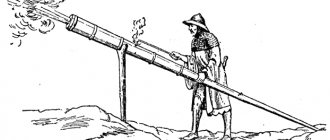
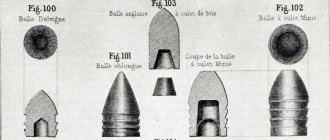
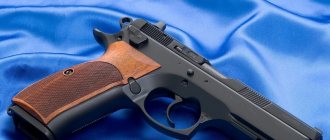
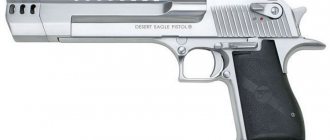
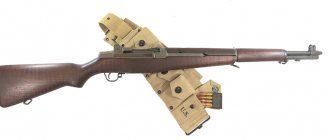


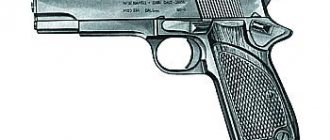
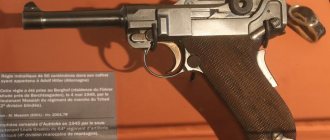

!['Domestic small arms [studio "Wings of Russia"] (2011)'](https://knifesburg.ru/wp-content/uploads/otechestvennoe-strelkovoe-oruzhie-studiya-krylya-rossii-2011-330x140.jpg)